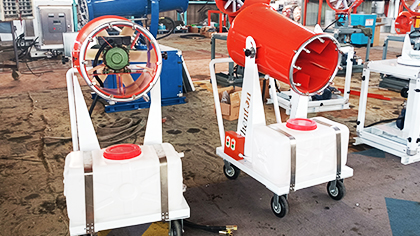Mine dust encompasses a variety of fine
particles produced during various stages
of mining operations.This includes mine
dust,coal dust,rock dust,and cement dust.
Mine dust exists as both floating dust and
falling dust,and can be classified into total
dust and respirable dust based on particle
size.
Let's delve into these types of dust in detail:
1.Floating Dust:This type of mineral dust remains
suspended in the air within the mine for extended
periods,hence the name floating dust.
2.Falling Dust:Falling dust is the type of mine dust
that settles due to its weight,depositing on the roof,
sides,floor,and objects in the mining roadway.It is
also known as sedimentary dust.
3.Total Dust:Total dust refers to all mine dust with
varying particle sizes.
4.Respirable Dust:This is the floating dust that can be
inhaled into the alveolar region of the human lungs.
Particles are smaller than 5 micrometers (µm) and
include both coal dust and rock dust.
Health and Environmental Impacts of Excessive Dust

Excessive dust in the workplace poses significant risks:
Environmental Pollution:Dust can severely pollute the
environment and impair visibility,which can affect
operational efficiency and safety.
Health Risks:
Inhaling large amounts of mineral dust can lead to
pneumoconiosis,a serious lung disease.Dust can also
cause eye irritation,vision loss,and respiratory tract
inflammation.
Safety Hazards:Dust can obscure hidden dangers,making
it difficult to detect potential accidents in a timely manner.
Effective Dust Control with Fog Cannon Machines
To address these issues,fog cannon machines have
emerged as a crucial solution for dust control.These
machines utilize advanced high-pressure spray
technology to combat airborne dust effectively.
Here's how they work:
Water Mist Technology:The fog cannon sprays fine
water mist particles that quickly bind with dust particles,
causing them to settle to the ground.This process
significantly reduces airborne dust.
Nano-sized Particles:The water mist particles are nano-
sized,which prevents the formation of water droplets
and avoids secondary pollution.
High Dust Suppression Rate:Fog cannon machines can
achieve a dust settling rate of approximately 90%,
making them highly efficient.
Water Conservation:Compared to conventional water
gun sprays,fog cannon machines use much less water,
conserving valuable resources.
For the well-being of workers and the protection of the
environment,implementing effective dust control
measures is essential.Fog cannon machines provide a
practical and efficient solution to manage mine dust,
ensuring a safer and healthier workplace.
By understanding the types of mine dust and their
associated risks,and utilizing advanced dust control
technologies,we can mitigate the harmful effects of
dust in mining operations.










